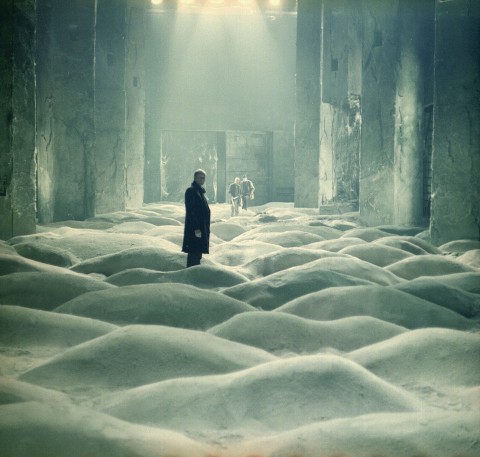-->
攝影藝術創作戰鬥營
《張美陵攝影藝術工作坊》
-->
這是給有毅力,有決心,絕不退縮的攝影愛好者的創作課程。
課程內容,分成兩部份:
1)討論學生的作品:以共同討論的方式,培養學生的視覺感知能力、造型综合能力、藝術創造能力、與文化分析概念。每次上課,學生需準備作品到課堂,公開討論作品與分享。
2)以當今世界各地的攝影藝術展覽作為案例:分析其美學觀念與操作策略,使學生瞭解世界攝影的現今發展概況。每期的課程討論不同的攝影展覽作品。
每次上課三小時,每兩星期上課一次,每班十人。
(請先傳來作品五張+創作說明,若報名人數太多則需分班)
課程地點:
台北市/台中市/高雄市(細節將再公佈與聯絡)
預定課程日期:二月底至五月底,八次一期。
隔週上課,每次上課三小時,7pm-10pm。
時間地點,還在喬~
請先報名以便規劃。
課程價格: 每人一期 $9000 ,舊生與在校學生九折。
-->
課程大綱 :
共同討論學生作品 + 分析2012年國外展覽
(針對一班學生的程度與需求,規劃討論內容,
並斟酌時間狀況,選擇分析討論下列展覽):
- Walker Evans & The American Social Landscape Photographers (Allentown Art Museum )
- Industrial Monuments: Photographs and Works on Paper from the Machine Age (Amon Carter Museum)
- Zwelethu Mthethwa: Front Room (Baltimore Museum Of Art)
- Enrique Metinides: Urban Archives: Rituals of Chaos (Bronx Museum of the Arts)
- W. Eugene Smith: Jazz Loft Project: W. Eugene Smith in NYC, 1957-1965 (Center for Creative Photography )
- DIY: Photographers & Books (Cleveland Museum of Art)
- 50 Greatest Photographs of National Geographic (Cleveland Museum of Natural History)
- The Radical Camera: New York’s Photo League, 1936-1951 (Contemporary Jewish Museum)
- Taryn Simon: A Living Man Declared Dead and Other Chapters I-XVIII (Corcoran Gallery of Art)
- Second Nature: Abstract Photography Then and Now (DeCordova Museum)
- Laura Letinsky: Still Life Photographs, 1997-2012 (Denver Art Museum)
- Carrie Mae Weems: Three Decades of Photography and Video (Frist Center for the Visual Arts)
- Ray K. Metzker: The Photographs of Ray K. Metzker and the Institute of Design (Getty Center)
- Robert Mapplethorpe (Getty Center)
- Gabriel Orozco: Asterisms (Guggenheim Museum)
- Freedom Of/For/To (Haggerty Museum of Art)
- Gordon Parks: 100 Years Installation (International Center of Photography)
- Sharon Lockhart: Noa Eshkol (Jewish Museum)
- After Photoshop: Manipulated Photography in the Digital Age (Metropolitan Museum of Art)
- Faking It: Manipulated Photography Before Photoshop (Metropolitan Museum of Art )
- Vik Muniz: Garbage Matters (Mint Museum)
- Photography & Science: An Essential Unity (MIT Museum)
- Ori Gersht: History Repeating (Museum Of Fine Arts, Boston)
- W. Eugene Smith and James Nachtwey (Museum of Fine Arts, Houston)
- The Shaping of New Visions: Photography, Film, Photobook (Museum of Modern Art)
- New Photography 2012: Michele Abeles, Birdhead (Ji Weiyu and Song Tao), Anne Collier, Zoe Crosher (Museum of Modern Art)
- Ruud van Empel: Strange Beauty (Museum of Photographic Arts)
- Jeff Liao: From Farm to City: Staten Island 1661-2012 (Museum of the City of New York)
- The Serial Portrait: Photography and Identity in the Last One Hundred Years (National Gallery of Art)
- Lalla Essaydi: Revisions (National Museum of African Art)
- Richard Ross: Juvenile-In-Justice (Nevada Museum of Art)
- Altared Spaces: The Shrines of New Mexico (New Mexico History Museum)
- Ken & Melanie Light: Valley of Shadows and Dreams (Oakland Museum of California)
- Louviere + Vanessa: Something Whispered, Something Sung (Ogden Museum of Southern Art)
- Barbara Bosworth: Natural Histories (Peabody Essex Museum)
- Cindy Sherman (Portland Art Museum)
- America in View: Landscape Photography 1865 to Now (RISD Museum of Art)
- Adad Hannah: Intimate Encounters (San Antonio Museum of Art)
- Rania Matar: A Girl and Her Room (Southeast Museum of Photography)
- Edward Burtynsky: Oil (Taubman Museum of Art)
- Kate Breakey: Las Sombras/The Shadows (Wittliff Collections)
教師:張美陵
藝術家、策展人、國立清華大學助理教授(兼任)。
美國紐約哥倫比亞大學教育學院人文與藝術學系藝術教育博士;國科會博士後研究員。許多次的個展、聯展、論文發表、全國攝影藝術比賽的評審。
策劃的展覽:
-《廣播早操的對話》 聯展;
-《出社會: 1990年代之後的台灣批判寫實攝影藝術》聯展(獲得2012年“十大公辦好展覽”的第一名。《藝術家》雜誌主辦的「視覺藝術年度票選」);
-《思想起:台灣攝影的社會敘事》 聯展(獲得2011年“麗水國際攝影文化節”最佳展覽獎)。
 Andrei Tarkovsky (1932-1986) firmly positioned himself as the finest Soviet director of the post-War period. But his influence extended well beyond the Soviet Union. The Cahiers du cinéma consistently ranked his films on their top ten annual lists. Ingmar Bergman went so far as to say, “Tarkovsky for me is the greatest [director], the one who invented a new language, true to the nature of film, as it captures life as a reflection, life as a dream.” And Akira Kurosawa acknowledged his influence too, adding, “I love all of Tarkovsky’s films. I love his personality and all his works. Every cut from his films is a marvelous image in itself.”
Andrei Tarkovsky (1932-1986) firmly positioned himself as the finest Soviet director of the post-War period. But his influence extended well beyond the Soviet Union. The Cahiers du cinéma consistently ranked his films on their top ten annual lists. Ingmar Bergman went so far as to say, “Tarkovsky for me is the greatest [director], the one who invented a new language, true to the nature of film, as it captures life as a reflection, life as a dream.” And Akira Kurosawa acknowledged his influence too, adding, “I love all of Tarkovsky’s films. I love his personality and all his works. Every cut from his films is a marvelous image in itself.”


.jpg)


